Frequently Asked Questions
Solar Panels- Will a solar panel produce electricity on a cloudy day?
- Will solar panels work in the winter?
- Will a solar panel supply electricity 24 hours a day?
- What size solar panel do I need?
- How can the panels be connected?
- What is the best orientation of a solar panel?
- How to calculate your solar panel needs
- What is a blocking diode?
- Can equipment be used directly from solar panels?
- Is maintenance required on solar panels?
- What are the possible problems?
- What problems might there be with mounting a solar panel?
- What is a charge controller?
- Do I need a charge controller?
- What is PWM?
- What is the load output of a charge controller?
- What is a MPPT solar charger controller?
- What are starter batteries?
- What are deep cycling batteries?
- What are VRLA batteries?
- What are AGM batteries?
- What are Gel batteries?
- What is SOC of a battery?
- How can you connect multiple batteries together?
- What is a power inverter?
- What is a modified or quasi sine wave inverter?
- What is a pure or true sine wave inverter?
- What size inverter do I need?
- How much power do inverters use?
- What is a grid tied inverter?
- High voltage cordless tool chargers
- Variable speed motors
- Electric shavers
- Garage door openers
- Fluorescent tubes (with ballasts)
- Fridge/Freezers
- Our 150W Power Inverter will run continuously at 150 watts, with up to 300 watt surge
- Our 300W Power Inverter will run continuously at 300 watts, with up to 600 watt surge
- Our 1000W Power Inverter will run continuously at 1000 watts, with up to 2000 watt surge
- Our 3000W Power Inverter will run continuously at 3000 watts, with up to 6000 watt surge
Solar Panels
Will a solar panel produce electricity on a cloudy day?
Yes, a solar panel does produce electricity even when it is not placed in bright sunlight. On a normal cloudy day there is always enough so-called diffuse light, by which the panel will produce electricity. However, the production of electricity is not as high as when the panels are placed in bright sunlight.
Will solar panels work in the winter?
Yes, solar panels work on light not heat. The amount of sun hours will be less in the winter, as the sun rises later and sets earlier.
Will a solar panel supply electricity 24 hours a day?
No, solar panels convert light into electricity. So as the light reduces in the day so does the output of the solar panel.
What size solar panel do I need?
This depends on the load you have connected to the battery. You will need to calculate the watt-hour or amp-hours you are using in a period of time (see FAQ How to calculate your solar panel needs), then having a rough idea of the amount of direct sunlight your solar panel will receive each day. The solar panel needs to supply approximately 20% more than your needs to compensate for variables, such as cloudy days etc. Obviously the winter will have shorter sunlight hours per day than the summer, but you can work on an average of approximately 4 hours sunshine a day in the UK over a year.
How can the panels be connected?
Solar Panels can be connected in parallel or series.
Solar Panels Connected In Parallel
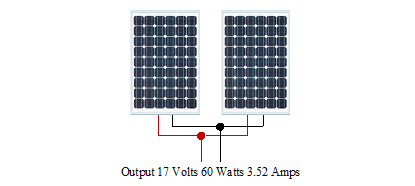
The diagram above shows 2 x 17 Volt 30 Watt Solar Panels connected in parallel each with a maximum current of 1.76A.
As you can see connecting the two solar panels together in parallel keeps the voltage the same, but doubles the wattage and current.
Solar Panels Connected In Series
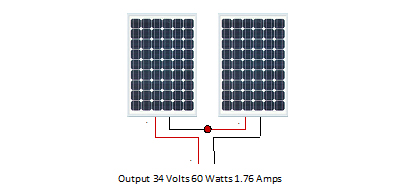
The diagram above shows 2 x 17 Volt 30 Watt Solar Panels connected in series each with a maximum current of 1.76A.
As you can see connecting two solar panels in series will double the voltage and wattage, but the current will stay the same.
What is the best orientation of a solar panel?
The sun rises in the East and sets in the West, but never goes North. Therefore if the Solar PV is facing South the more direct sunlight it will receive, which will produce more energy. To get the maximum benefit from the Solar Panel it needs to face between the South East and the South West otherwise its energy generation will be reduced. In the UK, the best angle is between 30 degrees and 45 degrees from horizontal.
How to calculate your solar panel needs
Battery Ampere Hour: The amp hour (ah) rating of a battery tells you how much amperage is available when discharged evenly over a period of time. The amp hour rating is cumulative, so in order to know how many constant amps the battery will output for a given period, you have to divide the amp hour rating by the amount of hours the load will be used.
Example: If a battery has an amp hour rating of 85, and it will be used for 20 hours dividing 85 (ah rating of battery) by 20 (hours of load) = 4.25. Such a battery can carry a 4.25 amp load for 20 hours before dropping to 10.5 volts. (10.5 volts is the fully discharged level, at which point the battery needs to be recharged.) Please be aware that it is not a good thing to discharge the battery fully. If the battery is fully discharged the solar panel may not be able to start the recharge, so add at least 20% more to your battery needs.
Please remember that these examples are for guidance only. The ratings of Solar panels are calculated in bright direct sunlight. Conditions such as indirect sunlight, cloudy, hazy conditions and partial shade will decrease the output. Also the length of daylight i.e.: summer vs. winter.
Calculating power using current and voltage
There are three ways of writing an equation for power, current and voltage:
Power = Current x Voltage so:
P = I x V
or
I = P divided by V
or
V = P divided by I
Where:
P = power in watts (W) P = power in milliwatts (mW)
V = voltage in volts (V) V = voltage in volts (V)
I = current in amps (A) I = current in milliamps (mA)
A milliwatt is a 1000th of 1 watt
A milliamp is a 1000th of 1 amp
Example: The Sunshine Solar Panels 80W - 12V Monocrystalline in peak light conditions will give approximately the following current using one of the above equations. We have the 2 variables, watts and volts so the following equation can be used. If the working voltage of the panel is 18 volts (to enable charging of the battery). I = P divided by V I = 80 divided by 18 = 4.44 amps So as the formula states that a 80 watt solar panel in peak light conditions will supply a current of 4.44 amps an hour.
Example: If we say that a 80 watt solar panel will supply 4.44 amps for a period of 5 hours (in the summer) it will replenish the battery with 22.2 amps in a day. If you have equipment which is connected to the battery that uses more than 22.2 amps per day then the solar panel you have may not be sufficient for your needs, as it will eventually drain your battery. Please remember that these examples are for guidance only. The ratings of Solar panels are calculated with light at 1000 w/m ² at a temperature of 25°. Conditions such as indirect sunlight, cloudy, hazy conditions and partial shade will decrease the output. Also the length of daylight i.e.: summer vs. winter.
What is a blocking diode?
This is a component connected within the cable that prevents the solar panel discharging the battery when there is no sunlight.
Can equipment be used directly from solar panels?
Yes, solar panels will run equipment direct, these could be loads such as fans and pumps, but make sure the load of the equipment is not equal to the output of the solar panel, as overcast or cloudy days will reduce the output. Solar panels with not run TV's or radio's (without battery backup), as they require a more stable voltage.
Is maintenance required on solar panels?
Clean using a non-abrasive cleaner. In the long term check the sealing especially in marine use and reseal with a silicon sealant if damage is suspected. Check battery connections periodically when you check battery levels. Fuse holders and connections should be kept dry and clean.
What are the possible problems?
Failure of a solar panel is normally due to water damage to the panel itself or the connections. Also damage to the sealant around the frame could cause failure. Mounting the panel incorrectly. If it is fixed horizontally it may be able to collect water. Not a sufficient air gap beneath the panel can also cause damage.
What problems might there be with mounting a solar panel?
Ideally the solar panel should have an incline of 30-40°, but this will be impractical if permanently mounting on a motorhome caravan or boat. Make sure there is an air gap beneath the panel when using solar panels with aluminium frames.
Solar Charge Controllers
What is a charge controller?
This device controls the charge to the battery and prevents battery drain at night. When the battery is fully charged the controller reduces the charging voltage to a float charge. The charge controller also has a load output which can be used to switch on or off a load (such as a light). This output can also protect the battery from over discharge. Some charge controllers have temperature sensors or probes, which measure ambient temperature and charges the battery accordingly.
Do I need a charge controller?
We recommend that charge controllers are used with 15 watt solar panels and above. This will ensure the battery is not overcharged if the solar panel is connected for any length of time with no charge being drawn.
What is PWM?
PWM, "Pulse Width Modulation" is one of the most efficient ways to charge a battery. When using PWM regulation, the current from the solar array is reduced by the charge controller. This happens as the battery reaches its fully charged state. This then reduces gassing of electrolyte so lengthens the battery life.
When a battery is fully charged a PWM solar charge controller will maintain the battery at its fully charged state by reducing the charge voltage to around 13 volts and monitors any slight changes to the battery voltage and changes the charging voltage accordingly.
What is the load output of a charge controller?
Some charge controllers will have +- load output terminals. These can be used to control a load and have the battery terminal voltage. The output load is commonly used for 12V lighting. Basic control will be to switch the load terminals on/off via a button on the charge controller. Other charge controllers will have the ability to control the load terminals by setting on and off times or dawn to dusk on time, this is helpful if lights need to be switched on/off automatically.
Another function of the output terminals is that if the battery gets to a discharged state (usually around 11V) the load terminals are switched off by the charge controller to prevent over discharge of the battery. The output will be switched on again when the solar panel has charged the battery to around 12.5V.
Please be aware
The maximum load connected to the load terminals will be determined by the rating of the regulator e.g. 10A regulator will equal 10A load, therefore it is not advisable to connect an inverter via the load output of a solar controller as the current draw in most cases may be far too high for the solar controller to handle and could cause serious damage to the solar controller.
What is a MPPT solar charger controller?
A maximum power point tracker (or MPPT) is a high efficiency DC to DC converter which functions as an optimal electrical load for a photovoltaic (PV) cell, most commonly for a solar panel or array. Any application which the PV module is the energy source, MPPT is used for detecting the variations in the current-voltage characteristics of solar cell. MPPT solar charge controller is necessary for any solar power system that needs to extract maximum power from PV module; it forces the PV module to operate at voltage close to maximum power point to draw maximum available power. MPPT allows users to use PV module with a higher voltage output than operating voltage of battery system. For example, if the PV module has to be placed far away from charge controller and battery, its wire size must be increased to reduce voltage drop. With a MPPT solar charge controller, users can wire the PV module for 24 or 48 V (depending on charge controller and PV modules) and bring the power into 12 or 24 V battery system. This means it reduces the wire size needed while retaining full output of PV module. The benefits of MPPT solar charge controllers are greatest during cold weather, on cloudy or hazy days or when the battery is deeply discharged.
Batteries
What are starter batteries?
Starter Batteries are used for starting engines, which need a lot of energy for a short period of time. They will not tolerate being discharged deeply. If they are repeatedly deeply discharged this will irreversibly damage the battery.
What are deep cycling batteries?
A battery designed so it can regularly be discharged to 20% of its maximum capacity without damage. These are the type of battery commonly used with a PV system. This is why these are used in caravans and motorhomes etc for use in supplying current to lights, inverters, water pumps and other equipment.
What are VRLA batteries?
These batteries are often called sealed lead-acid batteries, but they always include a safety pressure relief valve. The valve is a safety feature in case the rate of gas becomes dangerously high. A VRLA cannot spill its electrolyte if it is inverted.
What are AGM batteries?
AGM batteries are just like flooded lead acid batteries, except the electrolyte is being held in the glass mats, as opposed to freely flooding the plates. Very thin glass fibres are woven into a mat to increase surface area enough to hold sufficient electrolyte on the cells for their lifetime. Absorbed glass mat (AGM) is a class of VRLA battery in which the electrolyte is held on the glass mat separator by way of capillary action.
What are Gel batteries?
A Gel battery is a VRLA battery with a jellified electrolyte; the sulphuric acid is mixed with silica fume, which makes the resulting mass gel-like and immobile. Unlike a flooded wet-cell lead-acid battery, these batteries do not need to be kept upright.
What is SOC of a battery?
The State of Charge (SOC) of a battery describes how full a battery is. The exact voltage to battery charge correlation is dependent on the temperature of the battery. Cold batteries will show a lower voltage when full than hot batteries. This is one of the reasons why quality regulators or high-powered charging systems use temperature sensors or probes.
How can you connect multiple batteries together?
If you have a application that needs additional battery capacity you can connect batteries together in parallel or series.
Batteries Connected In Parallel
When connected in parallel the capacity of the batteries is added together.
See the diagram below.
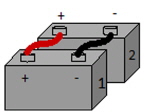
Battery 1 = 12V 110ah Battery
Battery 2 = 12V 110ah Battery
Total = 220ah at 12V
Please note: Same capacity and type of batteries must be used and the battery connecting leads must be the correct size for the system.
Batteries Connected In Series
When connected in series the capacity stays the same, but the voltage doubles.
See diagram below.

Battery 1 = 12V 110ah Battery
Battery 2 = 12V 110ah Battery
Total = 110ah at 24V
Please note: Same capacity and type of batteries must be used and the battery connecting leads must be the correct size for the system.
WARNING:
Batteries should be stored in a cool (but not freezing!), well ventilated place, out of reach of children. Remember that batteries are dangerous as they contain harmful acids and electricity. Old batteries should be disposed of as chemical waste.
Power Inverters
What is a power inverter?
A 12v or 24v inverter takes the DC (direct current) from a battery and creates 240vAC (Alternating current). Inverters have 2 ratings a maximum constant rating and a peak rating a 500-1000watt inverter can constantly run at a maximum of 500 watt and has a maximum peak of 1000 watts. The peak rating is usually used when an appliance starts.
What is a Modified or Quasi Sine Wave Inverter?
A Modified Sine wave inverter (sometimes referred to as Quasi Sine Wave Inverters) produces a modified AC supply from a 12vdc or 24vdc supply. As the name suggests the supply does not match a mains supply. These inverters are more affordable and are sufficient for most applications, but will not run the following:
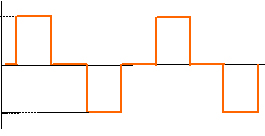
What is a Pure or True Sine Wave Inverter?
A Pure Sine Wave Inverter (sometimes referred to as True Sine Wave Inverters) supplies mains quality AC supply. This will run any appliance without interference and are therefore are most suited for use with sensitive electronic equipment allowing motors to run faster, quieter and cooler, preventing computer crashes, noises & glitches in monitors, TV, Game consoles etc in short a Pure Sine Wave Inverter will provide a reliable power source for all electronic appliances & devices.
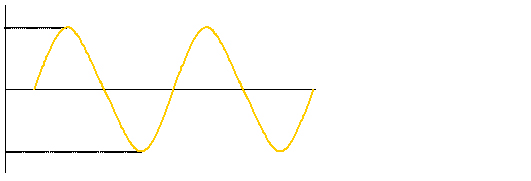
When choosing an inverter, make sure it's properly rated for your appliance. Check your appliances power requirement specification in the manual and then choose a model that has a continuous power rating that exceeds your appliances requirement. A good rule of thumb is to choose one that exceeds the requirement by about 20%. If you do plan to power additional devices off your inverter, add the wattage of all devices again, add at least 20%, and size the inverter accordingly. When running a microwave make sure you read your microwave power rating properly, the rating of cooking power will be lower than the actual power rating. The actual power (wattage W) rating will be found on a label on the back. Fridge freezers are a little more trickier to size an inverter for, as they can draw up to ten times their power rating when the compressor kicks in.
The most important thing to remember when choosing your inverter is to look carefully at the continuous power rating in the power inverters specifications, the surge power rating can almost be ignored and should not be used for sizing purposes.
For Example:
How much power do inverters use?
To calculate an approximation of what power the inverter may use, first find the power (wattage) rating of the appliance that will be used with the inverter and divide this wattage by eleven. So a small TV taking 100W (watts at 240vac) will be taking approximately 9 amps an hour off the battery.
Running an inverter will discharge the batteries overtime, but most inverters have battery over discharge protection. Once your battery drops to a certain point the inverter will sound an alarm or shutdown to let the user know battery power is getting low.
It is important to remember that to get the best performance from an inverter a good battery source is needed.
Most inverters draw a continuous current when they are switched on, even when nothing is connected to the output. This residual standby current could be around 0.3-1A or more depending on the size of the inverter. This may not sound like a lot, but if the inverter is left switched on for 24 hours and has a standby current of 1Ah then it could drain 24Amps from the batteries so it is important to switch the inverter off when not in use to preserve battery life.
A grid tied inverter converts solar panel charge into 240vac mains supply and is connected directly to a consumer unit. These inverters usually have larger panels connected in series to create strings. Depending on the size of the grid tied inverter these strings of solar panels are then connected in parallel to the Grid Tied inverter.
We hope these FAQ,s have helped and please feel free to contact us via e-mail or telephone if you require any further assistants.
Sunshine Solar Technical Team.
 Home
Home


